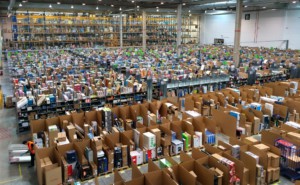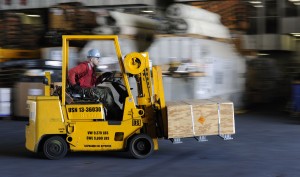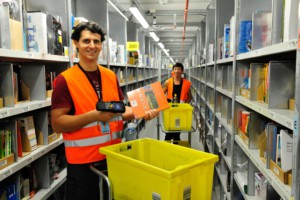 In my last post I looked at the disadvantages of fixed location storage. Usually much better is random chaotic storage. This is, for example, the preferred method of Amazon. This approach makes best use of the available space and generates less mistakes. When Amazon started using this, they reportedly were able to store twice as many items in the same space as as before.
In my last post I looked at the disadvantages of fixed location storage. Usually much better is random chaotic storage. This is, for example, the preferred method of Amazon. This approach makes best use of the available space and generates less mistakes. When Amazon started using this, they reportedly were able to store twice as many items in the same space as as before.
Random Chaotic … Meaning the Closest One for the Stowing Operator
 The complete opposite of fixed location is a random chaotic storage. Any item can be anywhere. This sounds easy, doesn’t it? Well, the challenge is to keep track of it. Forget pen and paper, forget Excel sheets. Now you definitely need a dedicated inventory management software. On the plus side, this random chaotic storage makes much better use of your space than fixed location storage, as I explained in my last post. Also, the same part type may be stored in different locations. This may go against your sense of order, but is part of the method.
The complete opposite of fixed location is a random chaotic storage. Any item can be anywhere. This sounds easy, doesn’t it? Well, the challenge is to keep track of it. Forget pen and paper, forget Excel sheets. Now you definitely need a dedicated inventory management software. On the plus side, this random chaotic storage makes much better use of your space than fixed location storage, as I explained in my last post. Also, the same part type may be stored in different locations. This may go against your sense of order, but is part of the method.

Of course, it is usually not truly random. I do not know of any system where a computer uses a random number generator to assign a truly random slot in the warehouse. What random chaotic usually means is that the worker who places the item in storage picks the spot. Hence, random chaotic actually is the closest free spot the operator can find. That is okay. Even better, that is actually good. Random chaotic reduces the walking distance of the operator who places the items. If the operator can pick the spot, then you also avoid problems if the spot is already taken. If a computer assigns a spot, then every now and then, due to errors, the spot may be already taken by something that should not be there.

Just make sure the operator correctly records the location and quantity of the items, preferably digitally with a scanner or a similar mistake-proof device. Ideally there should be three quick tasks for the operator: scan the item, scan the location, and place it in the location. Random chaotic has quite a few benefits, and is often considered a good inventory management approach.
- Space is used much more efficiently
- Storage is quicker, since the operator has to walk less
- The learning curve is faster, since workers do not need to memorize locations
- No disruptions due to an already-taken spot
- If the products are truly mixed, then you will have less picking errors. If you store your M10 screws right next to your M12 screws, sooner or later someone is going to pick the wrong screws.

On the downside, it requires a good computerized inventory management system. If the system is down, so is your factory, since you won’t be finding anything without the system. Also, if you need more than one part of the same type, you may have to walk to different locations until you have gathered enough of these parts (Thanks to Michel Baudin for the Suggestion!). But performance wise, this approach is very good. This is also the system Amazon uses for its fulfillment centers.
Individually Assigned Location
Having individually assigned location is a whole group of storage strategies. You do not have a fixed location that does not change, and neither does the operator decide the location for you as in random chaotic storage. Instead, some sort of algorithm decides on a case-by-case basis which part is stored where. The stowing operator is informed where he has to place the item. The advantage is that the inventory locations can be optimized more, but the operator now has to search for the correct location, which takes time and introduces more potential for errors. The best known approach is probably ABC storage.

ABC Storage
 ABC storage is a structured approach where the items to be stowed are assigned individual locations. You group your items into, typically, three categories. The A parts are required most frequently. The B parts are required less frequently. Finally, the C parts are the least-frequently retrieved items. Often, A parts are 80% of all retrievals, B parts are 15%, and C parts are the last 5% of all retrievals. As per the Pareto principle, 80% of all retrievals are about 20% of all parts in storage, whereas the remaining 20% of all retrievals are roughly 80% of the items.
ABC storage is a structured approach where the items to be stowed are assigned individual locations. You group your items into, typically, three categories. The A parts are required most frequently. The B parts are required less frequently. Finally, the C parts are the least-frequently retrieved items. Often, A parts are 80% of all retrievals, B parts are 15%, and C parts are the last 5% of all retrievals. As per the Pareto principle, 80% of all retrievals are about 20% of all parts in storage, whereas the remaining 20% of all retrievals are roughly 80% of the items.
The idea is to put the A parts in an easy-to-access location, the C parts in the farthest-away locations in the back, and the B parts somewhere in between. Then the worker or device that retrieves the items has to walk less, since the most frequent items are nearest to the point of demand.
Here, too, you can have variants. Generally, ABC sorting is by the frequency of retrievals, since you usually stow large batches and then retrieve multiple times in smaller batches. However, if your system stores more frequently than it retrieves (i.e., smaller outputs are added to a bigger batch, which is then shipped) you may sort by the frequency of storage operations. You can also imagine a combined value of both storing and retrieving, which should give you a good compromise.
Other criteria may be a bit more cumbersome but also possible. For example, you may opt to store large or heavy items in the front, rather than navigating through a maze of shelves.
Typically, three categories in ABC are used. However, feel free to use only two if you like; the result won’t be too much different. You could also go to the other end and use a gradient. The computer determines the retrieval (and/or storage) frequency, and then calculates how deep in the warehouse it should be stored. The computer then picks the closest free location, giving you a smidge more performance, but it will keep a programmer busy for a bit.
You could even go a bit further and consider which parts are used where. If you have one production line on one side of the warehouse, and another on the other side, you may have separate ABC categories for the different lines. The parts frequently needed by a line are stored closer to that line than to the other line that does not need them. But, while this sounds cool in theory, please be aware that this will be very tough to implement and debug, giving your shop floor people a lot of headaches while the computer guys try to figure out all the bugs. Even with computers, it may be best to keep it simple.
The advantage of this approach is that it tries to reduce the time needed for stowing (and retrieving), allowing more stowing (and retrieving) operations in a given time. It also uses the space quite well. It does, however, require a dedicated computer system. If the system is down, your factory is down.
In my next post I will look a bit at combinations and variations of fixed location, random chaotic, and individually assigned locations. Until then, stay tuned, and go out and organize your industry!

I really like how you explained the benefits of the random chaotic storage system as in my first internship at a warehouse, I was very confused as to why everything wasn’t organized in alphabetical order or in any order for that matter. The management team never really explained it to me and I was left with a sour taste in my mouth, thinking that we could be speeding up the picking process if we knew exactly where everything should be. After working there for the summer, everything you said in this blog makes perfect sense and I realized how its actually better.
I found this article insightful because it provided both the advantages and disadvantages for each storage strategy and why it would be the best fit for your type of business. Most of the time when I visit a random chaotic warehouse, I fail to see the upside of this kind of strategy. This article allowed me to see the positives in the different options and to keep an open mind.
Hello Cameron and Jose, I am glad my article was helpful 🙂
The method could be called by a more neutral and descriptive term like, say, “operator-directed putaway.” “Random chaotic” sounds derogatory and is not descriptive, as human decisions are neither chaotic nor random, at least in the sense of random sampling or random access.
In “random sampling“ as used in QC, each location would have an equal probability of being chosen.
Random access, as used in IT, means that every location is accessible in the same amount of time. ”RAM” stands for “Random-Access Memory,” as opposed to sequential access on a tape. A side-loading truck approximates random access; a rear-loading truck, sequential access.
And “random” in general is synonymous with both “probabilistic” and “stochastic.” It all depends if you prefer Germanic, Latin, or Greek roots.
You might also want to discuss picking. If you are picking individual pieces, As in an Amazon order for an electric toothbrush by a consumer, having the same item in several locations is OK. On the other hand, if you need to pick 50 screws from 5 different locations, it is problematic.
Hi Michel, excellent input as always. I updated the article to include the picking of multiple identical items (with reference to you, of course).
As for the name, that’s the way it is called. “Chaotic Storage” returns 27 million google hits, “Random Chaotic Storage” still 7 million. But I agree that it is a not so good name. My preference would be “first found space stowed”.
On the benefits parts explained:
– Space is used much more efficiently
– Storage is quicker, since the operator has to walk less
– The learning curve is faster, since workers do not need to memorize locations
– No disruptions due to an already-taken spot
– If the products are truly mixed, then you will have less picking errors. If you store your M10 screws right next to your M12 screws, sooner or later someone is going to pick the wrong screws.
You can still face disruption as you may have an empty location in front of the operator but still have inventory in the system (and it becomes a nightmare to retrieve the lost quantity).
And it is normally linked to your last point for M10 and M12 screws being side by side…
By the way, chaotic storage can, as a result, have 2 similar parts side by side but in both scenarii, your system should block you from picking, whether you stored chaotically or not.
brilliant Content… thx very much.
any thought on the potential benefits of chaotic storage in a general retail distribution center, vs generic product affinity/ABC put away principles?
Hi Werner, Amazon has chaotic storage, and it works well for them. It is hard to say, however, which one is better. I think it depends on the system.
Any thoughts on the trade off of random storage and search time in bins for operators? Ie this is more efficient up to N items in a bin, and search time in random chaotic storage makes it not worthwhile after that point? Thinking of apparel for example, chaotic storage of many like SKUs in a bin could result in very long pick search times.
Hello Paul, this is probably hard to generalize. While in Amazon they store randomly, the more precisely you keep track of what you put where the easier it is to find it. I also have seen systems of plastic trays in an automated storage system, where a light shined on the spot in the tray (e.g. upper left, center, …) where the item was placed. It is a trade off between an upfront investment in data quality and a afterward effort to find the stuff.
Excellent post, even if a lot of it is common friggin sense. I do have a couple questions though.
“Just make sure the operator correctly records the location and quantity of the items, preferably digitally with a scanner or a similar mistake-proof device. Ideally there should be three quick tasks for the operator: scan the item, scan the location, and place it in the location.”
This one is far, far more difficult to consistently achieve in practice. Especially when a facility has high employee turnover tastefully paired up with chronic understaffing and low wages. Such as a satellite store of a major auto parts chain I currently work at. Our hub store does have an area with full on free slot system. Even over there, the access to it is restricted to a relatively small subset of employees who can be trusted not shove random product into a random spot without a care in the world. But normally, storage areas are separated by component type. So you won’t have things like radiators, crankshaft position sensors, and mufflers stored in the same spot. This also adds a visual aid to spot items that are way out of place.
Most sensible places use some form of ABC just like we do. One dimension your post kind of omits is height. Items that require a ladder to reach are far more expensive to pick in terms of time and effort than the ones within reach from the floor. That’s one of the projects I’m currently heading. And that is to identify the stuff we don’t sell a lot of, and relocate it to the top shelves where it can gather dust without taking up primo space that’s better used for higher turnover inventory.
Not too long ago, we did move all of the MAF sensors and oxygen sensors to be reachable without needing a ladder. Jokingly, I gave the good news/bad news to the team. The bad news being that the new goal is to sell at least one oxygen sensor per hour, but the good news being that they are not quick and easy to grab.
Good point, Andrey . Not only in random storage but general in inventory management, good data quality is hard to achieve. When I was still working in industry, missing parts that “should” have been there were a constant bane of my existence. I believe such data problems are often worst in inventory management due to the frequency of change. It needs a good system, but also employees that are properly trained and use the system correctly.
Also good point on the height/accessibility. Easy access is a premium location. Thanks for sharing!
It comes down to load balancing. Sure it’s fast on the put away side. People never seem look at the whole equation. You can’t just take one part and talk about how great it is. You always need to consider the context. For amazon, it’s fine. For me, I order something small and it says can’t be ordered alone due to the cost of shipping. Okay I’ll buy 2 things, now it let’s me order. Guess what? Both are shipped separately anyway. Did amazon lose money on that? Yes.
Point being, you need an equivalence ratio that includes all factors, such as unloading, receipt, storage, put away, picking, packing, shipping. Loss prevention…
How much time are you spending on support when things go wrong? Such as an item is missing? Some of that is beyond the scope of the article but should be mentioned.